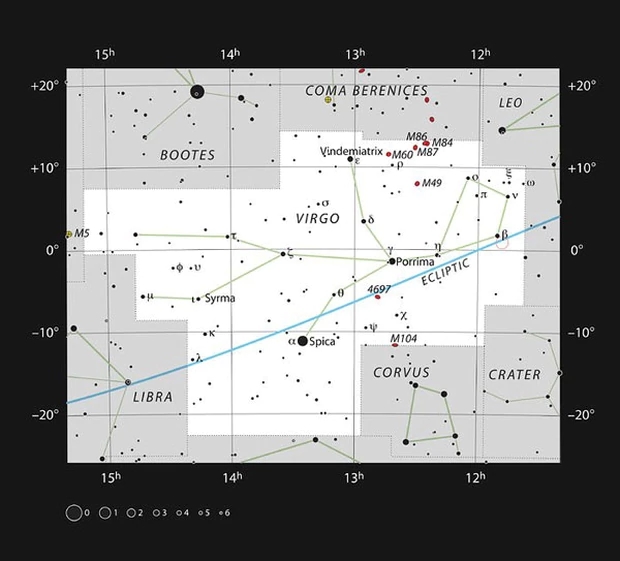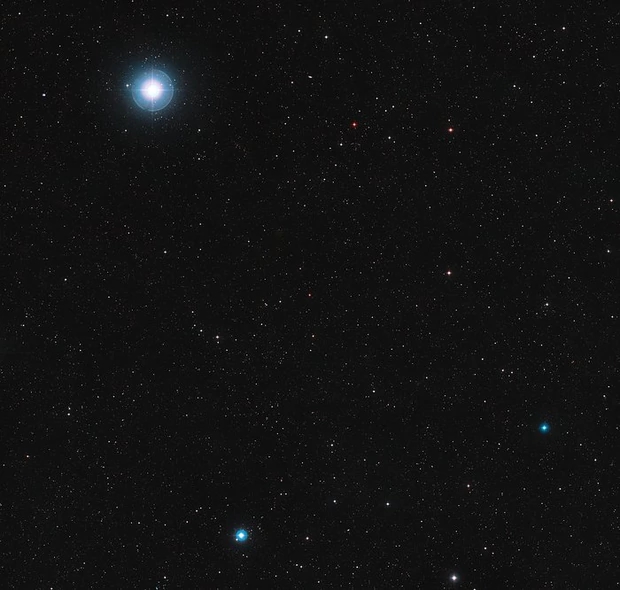ROSS 128b: It's the latest best address in intergalactic real estate.
It's Earth sized.
It sits in a "Goldilocks Zone" where it's neither too hot, nor too cold, for liquid water.
The star it orbits is gentle and calm.
It's just 11 light-years away. And getting closer.
Now it's the focus of attention for the European Southern Observatory, which is set to scour scattered photons of light coming from its direction for clues as to the makeup of its atmosphere.

This chart shows the zodiacal constellation of Virgo (The Virgin). This constellation is home to the faint red dwarf star Ross 128, marked with an open red circle, also sometimes known as Proxima Virginis. (Photo / ESO)

This image shows the sky around the red dwarf star Ross 128 in the constellation of Virgo (The Virgin). (Photo / ESO)
"Life is something that seems to need liquid water. But it probably also needs other things we don't know about," Lineweaver says.
"We know so little about habitability, it's difficult to say what it is. What does it take to get life started? We just don't know.
"If M-class red dwarfs are good host stars for life, why aren't we around one?"
SHORTCUT TO HAPPINESS
Red dwarf stars are the most common stars in the known universe.
But they're also among the coolest and smallest - making them ideal to examine for the telltale flickers and wobbles that give away the presence of orbiting planets.
Study lead author Xavier Bonfils (Institut de Planétologie et d'Astrophysique de Grenoble - University Grenoble-Alpes/CNRS, Grenoble, France) says their HARPS telescope program was nicknamed "The shortcut to happiness" as it is easier to detect small cool siblings of Earth around these stars, than around stars more similar to the Sun.
But most red dwarf stars are unstable.
"Many red dwarf stars, including Proxima Centauri, are subject to flares that occasionally bathe their orbiting planets in deadly ultraviolet and X-ray radiation," the statement reads. "However, it seems that Ross 128 is a much quieter star, and so its planets may be the closest known comfortable abode for possible life."
But Lineweaver says that while Ross 128 is stable now, that wasn't the case in its youth.
M-class stars (red dwarfs) are very luminous when born, decreasing rapidly over their first billion years by a factor of 100.
"What this means is any close planets were being blasted for their first billion years - which has huge implications as to whether or not any water survived on their surface," he says.
"This could completely eliminate the possibility of life developing later on. Not much thought has gone into that yet."
Red dwarf stars are getting all the attention because they're easier to analyse via current techniques: Their planets orbit quickly - mostly a matter of days.
Using similar techniques to detect a planet similar to Earth orbiting a yellow sun could take up to a century, he says.
"It's not that planets don't exist around stars like our Sun. We're just not in a position to say that for certain. But we are in a position today that, statistically, we're pretty sure they exist."
NOSY NEIGHBOURS
"Astronomers are now detecting more and more temperate exoplanets, and the next stage will be to study their atmospheres, composition and chemistry in more detail," the ESO researchers say.
ROSS 128b could offer an ideal opportunity to do just that.
"Biomarkers" such as oxygen in an exoplanet's atmosphere leave "imprints" on the light which passes through, or reflects off, an atmosphere. Finding these will be a "huge next step" in our understanding of just how habitable the universe may be, the ESO says.
But our current technology only allows us to extract such data from a limited selection of stars.
The ESO's Extremely Large Telescope (ELT) is in a prime position to do just that with the likes of Ross 128b.
It's undergoing an upgrade to further refine its observations of Earth-sized exoplanets.
"In particular, NIRPS, the infra-red arm of HARPS, will boost our efficiency in observing red dwarfs, which emit most of their radiation in the infra-red. And then, the ELT will provide the opportunity to observe and characterise a large fraction of these planets," Bonfils says.
The process of extracting these "fingerprints" is time consuming, says Lineweaver, with enough photons needing to be captured to map out a comprehensive spectrum defining.
"Even then we won't have an unambiguous 'hey this is it, this is life' - because we don't know what that is," he says.
But the race is on to figure that out.
"The precision of these instruments is incredible, the amount of effort is incredible," Lineweaver says.
But when it comes to the sensitivity to separate the light of distant stars into detailed "absorption line" biomarkers - we're not there yet.
"That's the task of the next generation of instruments that are being thought about now," he says.
"This is a whole new science that is only just beginning. A whole bunch of scientists are piling into the field, which is why we're making so much progress."
Take your Radio, Podcasts and Music with you









